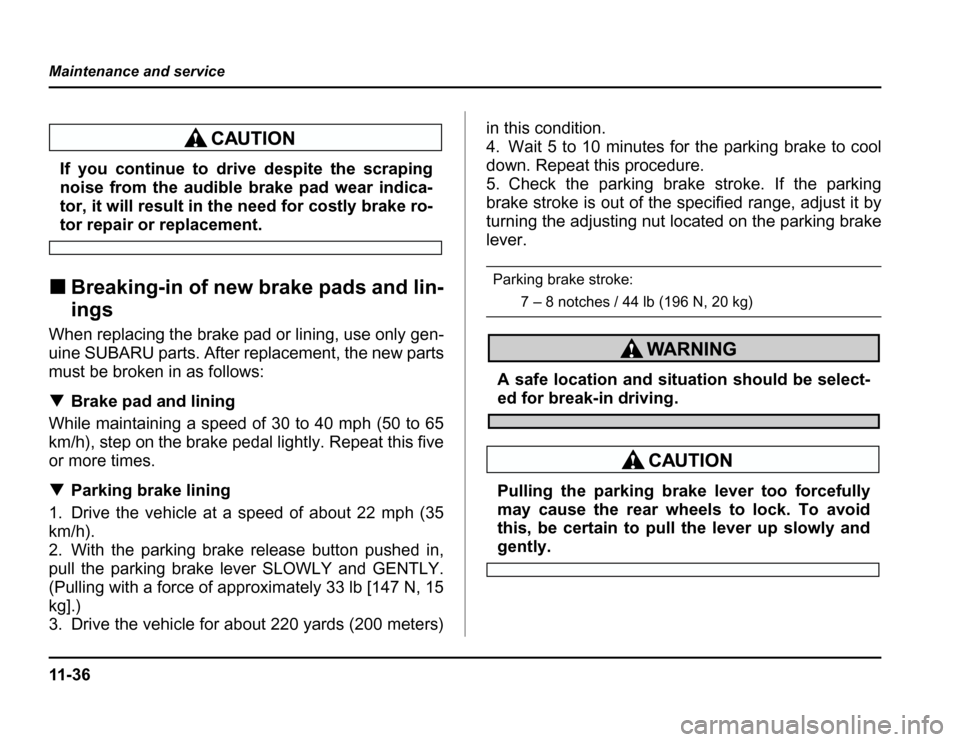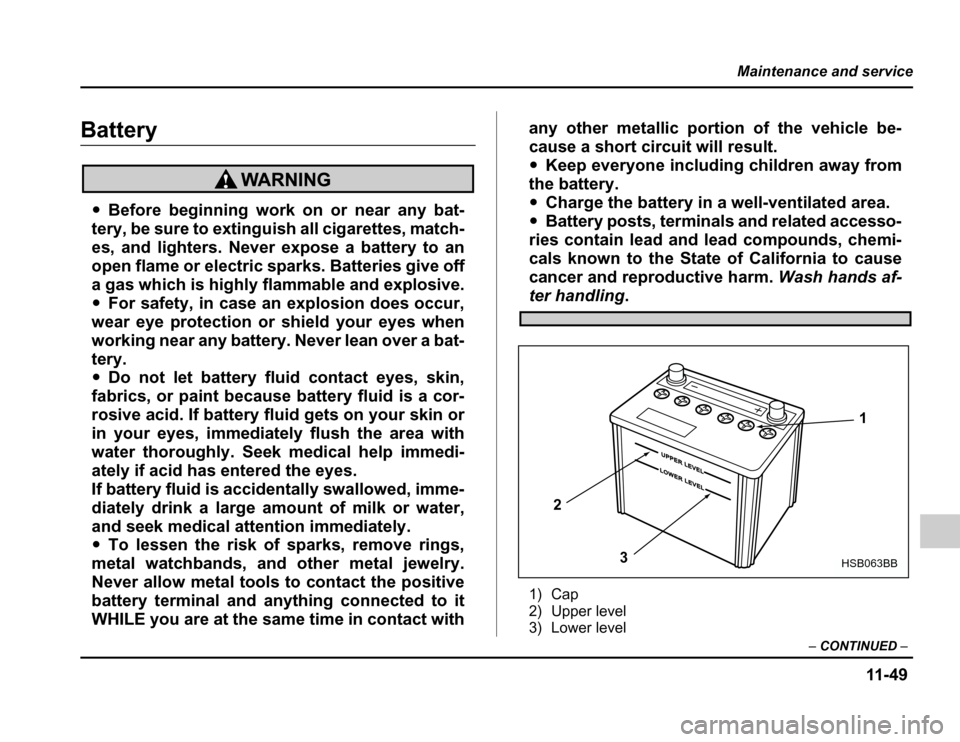Page 364 of 420
11 -3 3
Maintenance and service
–CONTINUED –
Brake pedal
Check the brake pedal free play and reserve distance
according to the maintenance schedule in the “War-
ranty and Maintenance Booklet”. �Checking the brake pedal free play
1) 0.04–0.12in(1.0–3.0mm)
Stop the engine and firmly depress the brake pedal
several times. Lightly press the brake pedal down with
one finger to check the free play with a force of less
than2lb(10N,1kg).
If the free play is not within proper specification, con- tact your SUBARU dealer.
� Checking the brake pedal reserve dis- tance
1) More than 2.56 in (65 mm)
Depress the pedal with a force of approximately 66 lb
(294 N, 30 kg) and measure the distance between the
upper surface of the pedal pad and the floor.
When the measurement is smaller than the specifica-
tion, or when the pedal does not operate smoothly,
contact with your SUBARU dealer.
1
HSB049BB
1
HSB050BB
Page 365 of 420
11 - 3 4
Maintenance and service
Clutch pedal (MT vehicles)
Check the clutch pedal free play and reserve distance
according to the maintenance schedule in the “War-
ranty and Maintenance Booklet”. �
Checking the clutch function
Check the clutch engagement and disengagement.
1. With the engine idling, check that there are no ab-
normal noises when the clutch pedal is depressed,
and that shifting into 1st or reverse feels smooth.
2. Start the vehicle by releasing the pedal slowly to
check that the engine and transmission smoothly cou-
ple without any sign of slippage. �
Checking the clutch pedal free play
1) 0.16 – 0.51 in (4.0 –13.0 mm)
Lightly press the clutch pedal down with your finger
until you feel resistance, and check the free play.
If the free play is not within proper specification, con-
tact your SUBARU dealer.
1
HSB049BB
Page 367 of 420

11 - 3 6
Maintenance and service
If you continue to drive despite the scraping
noise from the audible brake pad wear indica-
tor, it will result in the need for costly brake ro-
tor repair or replacement.
� Breaking-in of new brake pads and lin- ings
When replacing the brake pad or lining, use only gen-
uine SUBARU parts. After replacement, the new parts
must be broken in as follows: � Brake pad and lining
While maintaining a speed of 30 to 40 mph (50 to 65
km/h), step on the brake pedal lightly. Repeat this five
or more times. � Parking brake lining
1. Drive the vehicle at a speed of about 22 mph (35
km/h).
2. With the parking brake release button pushed in,
pull the parking brake lever SLOWLY and GENTLY.
(Pulling with a force of approximately 33 lb [147 N, 15kg].)
3. Drive the vehicle for about 220 yards (200 meters) in this condition.
4. Wait 5 to 10 minutes for the parking brake to cool
down. Repeat this procedure.
5. Check the parking brake stroke. If the parking
brake stroke is out of the specified range, adjust it by
turning the adjusting nut located on the parking brake lever.
Parking brake stroke:
7 – 8 notches / 44 lb (196 N, 20 kg)
A safe location and situation should be select-
ed for break-in driving.
Pulling the parking brake lever too forcefully
may cause the rear wheels to lock. To avoid
this, be certain to pull the lever up slowly and
gently.
Page 372 of 420
11 -4 1
Maintenance and service
–CONTINUED –
ly and to rapidly become hot. A sharp increase
in temperature could cause tread separation,
and destruction of the tires. The resulting loss
of vehicle control could lead to an accident.
� Wheel balance
Each wheel was correctly balanced when your vehicle
was new, but the wheels will become unbalanced as
the tires become worn during use. Wheel imbalance
causes the steering wheel to vibrate slightly at certain
vehicle speeds and detracts from the vehicle’s
straight-line stability. It can also cause steering and
suspension system problems and abnormal tire wear.
If you suspect that the wheels are not correctly bal-
anced, have them checked and adjusted by your
SUBARU dealer. Also have them adjusted after tire re-
pairs and after tire rotation.
NOTE
Loss of correct wheel alignment* causes the tires
to wear on one side and reduces the vehicle
Page 380 of 420

11 -4 9
Maintenance and service
–CONTINUED –
Battery
�Before beginning work on or near any bat-
tery, be sure to extinguish all cigarettes, match-
es, and lighters. Never expose a battery to an
open flame or electric sparks. Batteries give off
a gas which is highly flammable and explosive.� For safety, in case an explosion does occur,
wear eye protection or shield your eyes when
working near any battery. Never lean over a bat-tery. � Do not let battery fluid contact eyes, skin,
fabrics, or paint because battery fluid is a cor-
rosive acid. If battery fluid gets on your skin or
in your eyes, immediately flush the area with
water thoroughly. Seek medical help immedi-
ately if acid has entered the eyes.
If battery fluid is accidentally swallowed, imme-
diately drink a large amount of milk or water,
and seek medical attention immediately. � To lessen the risk of sparks, remove rings,
metal watchbands, and other metal jewelry.
Never allow metal tools to contact the positive
battery terminal and anything connected to it
WHILE you are at the same time in contact with any other metallic portion of the vehicle be-
cause a short circuit will result.�
Keep everyone including children away from
the battery.� Charge the battery in a well-ventilated area.
� Battery posts, terminals and related accesso-
ries contain lead and lead compounds, chemi-
cals known to the State of California to cause
cancer and reproductive harm. Wash hands af-
ter handling.
1) Cap
2) Upper level
3) Lower level
UP P E
R LE V E
LUPPER LEVEL
LOWER LEVELLOWER LEVEL
1
2 3
HSB063BB
Page 383 of 420
11 - 5 2
Maintenance and service
A) Good
B) Blown
If any lights, accessories or other electrical controls do
not operate, inspect the corresponding fuse. If a fuse
has blown, replace it.
1. Turn the ignition switch to the “LOCK” position and
turn off all electrical accessories.
2. Remove the cover.
3. Determine which fuse may be blown. The back side
of each fuse box cover and the “Fuses and circuits”
section in chapter 12 in this manual show the circuit for
each fuse. 1) Fuse puller
4. Pull out the fuse with the fuse puller.
5. Inspect the fuse. If it has blown, replace it with a
spare fuse of the same rating.
6. If the same fuse blows again, this indicates that its
system has a problem. Contact your SUBARU dealer
for repairs.
AB
HSB067BB
1
HSB068BB
Page 384 of 420
11 -5 3
Maintenance and service
–CONTINUED –
Main fuse
Main fuse box
The main fuses are designed to melt during an over-
load to prevent damage to the wiring harness and
electrical equipment. Check the main fuses if any elec-
trical component fails to operate (except the starter
motor) and other fuses are good. A melted main fuse
must be replaced. Use only replacements with the
same specified rating as the melted main fuse. If a
main fuse blows after it is replaced, have the electrical
system checked by your nearest SUBARU dealer.Installation of accessories
Always consult your SUBARU dealer before installing
fog lights or any other electrical equipment in your ve-
hicle. Such accessories may cause the electronic sys-
tem to malfunction if they are incorrectly installed or if
they are not suited for the vehicle.
HSB065BA
Page 385 of 420
11 - 5 4
Maintenance and service
Replacing bulbs
4
3
2
1
56
7 89
10 11 1213
14
HSB069BB
Wattage Bulb No.
1) Headlight 12V–60/ 55WHB2 (H4)
2) Parking light 12V–5W 168
3) Map light 12V–8W —
4) Dome light 12V–8W —
5) Side marker light (Front) 12V–5W 168
6) Front turn signal 12V–21W (Amber)1474
7) Front fog light 12V–55W —
8) High mount stop light 12V–13W 912
9) Cargo area light 12V–5W —
10) Tail/stop light 12V–21/ 5W7443
11) Rear turn signal 12V–21W (Amber)1474
12) Backup light 12V–16W 921
13) Tail/stop light 12V–21/ 5W7443
14) Licence plate light 12V–5W 168